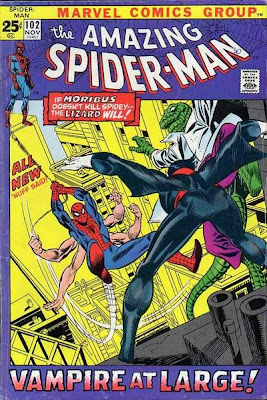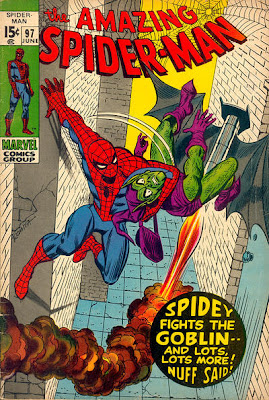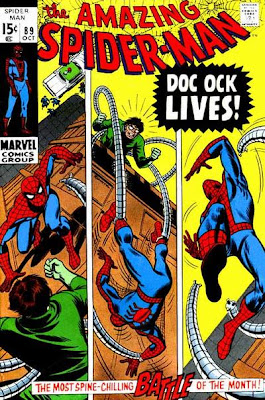"WALK THE SAVAGE LAND!"
Written by Roy Thomas
Drawn by Gil Kane
Inked by Frank Giacoia
Lettered by Artie Simek
What happens:
The Daily Bugle's in financial trouble. It needs a big story and it needs it now. So J Jonah Jameson decides to mount an expedition to the Savage Land to get photos of a giant creature called Gog, rumoured to be lurking there. Among the team he takes are Peter Parker and Gwen Stacy but, once there, Gog appears and takes Gwen, with Peter sent flying into a river.
Away from the prying eyes of the others, Peter changes into his Spider-Man suit and goes after the beast. But, getting over-confident, he lands in quicksand and, at the tale's end, is rapidly sinking, with no means of escape.
The Verdict:
So, after last issue's take on Dracula, this month we get Roy Thomas' take on King Kong in what has to be one of the silliest adventures Spider-Man's ever had. It's interesting to contrast Thomas' approach to that of Stan Lee. Whereas Lee had worked hard to tie Spidey into the real world, keeping his adventures in New York and introducing real life political and social issues, Thomas goes for out-and-out fantasy. I have to say I prefer the Lee approach. I'm a big fan of Thomas' work on things like the Avengers and Conan but, somehow it never quite feels like it belongs on a strip like Spider-Man. It's a beautifully drawn tale though from Gil Kane. I especially like the Daily Bugle scenes with the editorial conference.
I have to say the handling of Gwen Stacy in this issue irks me. For one thing, she's blubbing her eyes out again - I really wish she'd stop doing that - and, for another, the whole blundering around in the jungle in a bikini is terrible. I know Roy Thomas has been accused of sexism over the years but this is taking liberties.
Peter Parker uses a gun. Peter Parker should never use a gun.
Interesting to see that Kraven wants Gwen for his mate. Clearly we should never read anything into the fact that he barges around looking like the sixth member of the Village People.
The Daily Bugle's in financial trouble. It needs a big story and it needs it now. So J Jonah Jameson decides to mount an expedition to the Savage Land to get photos of a giant creature called Gog, rumoured to be lurking there. Among the team he takes are Peter Parker and Gwen Stacy but, once there, Gog appears and takes Gwen, with Peter sent flying into a river.
Away from the prying eyes of the others, Peter changes into his Spider-Man suit and goes after the beast. But, getting over-confident, he lands in quicksand and, at the tale's end, is rapidly sinking, with no means of escape.
The Verdict:
So, after last issue's take on Dracula, this month we get Roy Thomas' take on King Kong in what has to be one of the silliest adventures Spider-Man's ever had. It's interesting to contrast Thomas' approach to that of Stan Lee. Whereas Lee had worked hard to tie Spidey into the real world, keeping his adventures in New York and introducing real life political and social issues, Thomas goes for out-and-out fantasy. I have to say I prefer the Lee approach. I'm a big fan of Thomas' work on things like the Avengers and Conan but, somehow it never quite feels like it belongs on a strip like Spider-Man. It's a beautifully drawn tale though from Gil Kane. I especially like the Daily Bugle scenes with the editorial conference.
I have to say the handling of Gwen Stacy in this issue irks me. For one thing, she's blubbing her eyes out again - I really wish she'd stop doing that - and, for another, the whole blundering around in the jungle in a bikini is terrible. I know Roy Thomas has been accused of sexism over the years but this is taking liberties.
Peter Parker uses a gun. Peter Parker should never use a gun.
Interesting to see that Kraven wants Gwen for his mate. Clearly we should never read anything into the fact that he barges around looking like the sixth member of the Village People.







































.JPG)














